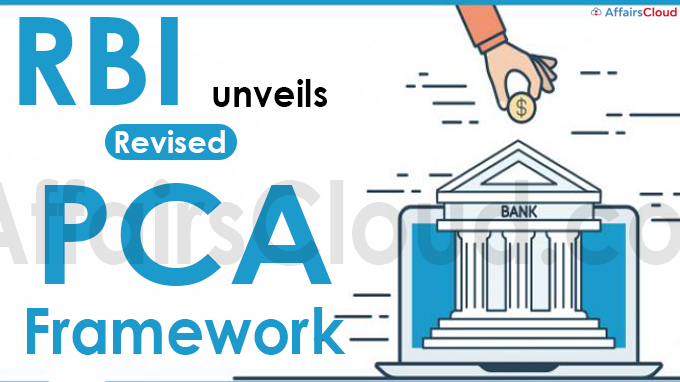
- Under the revised framework, Capital, Asset Quality and Leverage will act as the key areas for monitoring. (Capital, Asset quality and Profitability were the key areas for monitoring in 2017’s framework).
- The provisions of the revised PCA Framework will be effective from January 1, 2022.
Revised PCA Framework:
|
Parameter |
Indicator |
Risk Threshold 1 |
Risk Threshold 2 |
Risk Threshold 3 |
|---|---|---|---|---|
|
Capital (Breach of either CRAR or Common Equity Tier 1 ratio) |
CRAR – Minimum regulatory prescription for CRAR + applicable CCB
and/or
Regulatory Pre-Specified Trigger of Common Equity Tier 1 Ratio (CET 1 PST) + applicable CCB |
Up to 250 bps (basis points) below the prescribed Indicator
Up to 162.50 bps below the prescribed Indicator |
More than 250 bps but not exceeding 400 bps below the prescribed Indicator
More than 162.50 bps below but not exceeding 312.50 bps below the prescribed Indicator |
In excess of 400 bps below the prescribed Indicator
In excess of 312.50 bps below the prescribed Indicator |
|
Asset Quality |
Net Non-Performing Advances (NNPA) ratio |
>=6.0% but <9.0% |
>=9.0% but < 12.0% |
>=12.0% |
|
Leverage |
Regulatory minimum Tier 1 Leverage Ratio |
Upto 50 bps below the regulatory minimum |
More than 50 bps but not exceeding 100 bps below the regulatory minimum |
More than 100 bps below the regulatory minimum |
CARA – Capital to Risk (Weighted) Assets Ratio; CCB – Capital Conservation Buffer
Mandatory actions for breaching the threshold:
|
Specifications |
Mandatory actions |
|---|---|
|
Risk Threshold 1 |
Restriction on dividend distribution/remittance of profits. |
| Promoters/Owners/Parent (in the case of foreign banks) to bring in capital | |
|
Risk Threshold 2 |
Mandatory actions of Threshold 1 and
Restriction on branch expansion; domestic and/or overseas |
|
Risk Threshold 3 |
Mandatory actions of Threshold 1 & 2 and Restrictions on capital expenditure, other than for technological upgradation within Board approved limits |
About PCA Framework:
What is PCA?
i.PCA is a framework under which banks with weak financial metrics are put under watch by the RBI. Under the Framework, the supervised Entity will be required to initiate and implement remedial measures in a timely manner to restore its financial health.
ii.The RBI introduced the PCA framework in December 2002 as a structured early-intervention mechanism to supervise and regulate the banks that become undercapitalised due to poor asset quality, or vulnerable due to loss of profitability.
iii.The regulations were later revised in April 2017.
Features of PCA Framework:
i.The PCA Framework will also act as a tool for effective market discipline and it does not prevent the RBI from taking any other action as it deems fit at any time, in addition to the corrective actions prescribed in the Framework.
ii.A bank will be placed under PCA framework based on the Audited Annual Financial Results and the ongoing Supervisory Assessment made by RBI.
Note – Following Indian Overseas Bank’s exit from PCA in September 2021, Central Bank of India was the only bank that was remaining under PCA.
Recent Related News:
On March 10, 2021, RBI removed LIC – owned Industrial Development Bank of India (IDBI) from its enhanced regulatory supervision, the Prompt Corrective Action (PCA) framework, after almost 4 years, on improved financial performance and credit profile.